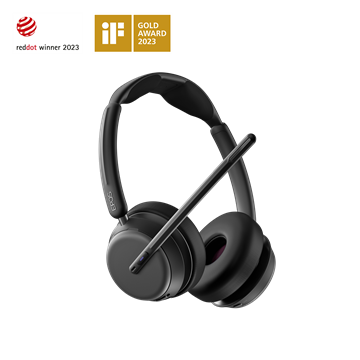EPOS BrainAdapt™ a Dual Task Study
EPOS latest scientific whitepaper “The effect of noise attenuation on listening effort, efficiency and reaction time, while performing a dual task”
[Updated 30/1-24] - People often perform more than one task at a time, without even realizing it. Many situations in everyday life involve understanding speech and, at the same time, solving a task visually. In professional contexts today, people often need to listen to a colleague speaking while identifying information on a screen, in noisy, open office environments. Despite being common situations, performing more than one task at a time is often challenging, and one may need to prioritize one task over the other(s) to maintain a certain level of performance. This is because performing one or more tasks requires using cognitive capacity.
The clinical study* presented EPOS’ most recent whitepaper evaluated the potential benefits of noise attenuation, or noise reduction, in audio devices, while people performed a dual task consisting of understanding speech while reacting to a visual task. The goal was to evaluate how noise attenuation affects people’ ability to recognize speech-in-noise recognition, their listening effort and overall cognitive resource allocation in a dual task paradigm.
What We Found Out
The results of the study indicate that noise attenuation provides several benefits for participants with normal hearing when performing a dual task is required. When noise was attenuated during a dual task, speech-in-noise recognition improved up to 48.2 percentage points. Additionally, applying noise attenuation led to a significant decrease in perceived listening effort, on average, up to 67.5 percentage points relative to No Attenuation, as reflected by the subjective listening effort ratings. When the noise was attenuated, pupil dilation was also significantly reduced while listening to the sentence indicating less listening effort. Freeing up cognitive resources allowed the participants to perform the visual reaction time task quickly and accurately.
For professionals today who can often work from anywhere, at any time, these new modern work environments bring distractions and ambient noises – making it challenging for employees to stay engaged, perform and be productive. EPOS audio devices built on BrainAdapt™ technology frees up cognitive resources and improves performance, by minimizing brain effort spent on listening and understanding speech.
A Dual Task Study
The research was conducted by EPOS at the Centre for Applied Audiology Research (CAAR)1, Oticon, Denmark, with a focus on pupillometry tracking, speech recognition performance and subjective listening effort ratings for each noise condition. The users performed the listening and visual task when the background noise was Attenuated and when the background noise was not Attenuated, with the visual task only used as the baseline.
This study is just one example of decades of psychoacoustic research conducted by the Demant Group, of which EPOS is proud to be a part. The learnings collected in this study and others, are applied in ongoing development of EPOS BrainAdapt™ solutions, which are designed to support the brain’s natural way of processing sound.
The technology tested in this study is featured in the following EPOS Enterprise products:
- IMPACT 1060 ANC
- IMPACT 1060T ANC
- IMPACT 1061 ANC
- IMPACT 1061T ANC
- IMPACT 860T ANC
- IMPACT 860 ANC
- ADAPT 600 Series


